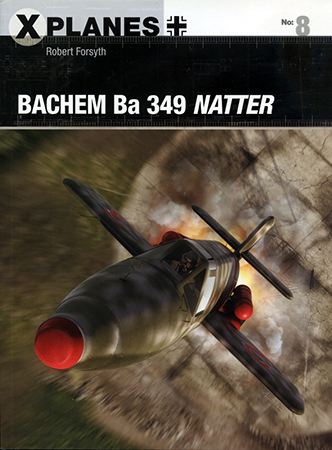
Bachem Ba 349 Natter Book Review
By David L. Veres
| Date of Review | July 2018 | Title | Bachem Ba 349 Natter |
|---|---|---|---|
| Author | Robert Forsyth | Publisher | Osprey Publishing |
| Published | 2018 | ISBN | 9781472820099 |
| Format | 80 pages, softbound | MSRP (USD) | $20.00 |
Review
Desperation definitely dominated Nazi Germany's descent to defeat.
Scientists and engineers, visionaries and charlatans vied to produce war-winning Wunderwaffen – especially to counter relentless Allied air attacks.
Bachem's vertically-launched, point-defense, rocket-powered Natter remains among the few that actually reached prototype status.
Now Robert Forsyth tells the tale in Bachem Ba 349 Natter – eighth in Osprey's growing X-Planes range.
Coverage commences with background notes on Germany's nascent rocket development efforts. Despite Versailles Treaty limitations, Germany sought military applications for innovative technologies. And rockets proffered paradigm-shifting potential.
Ba 349 development – including unsuccessful Heinkel and Junkers competitors – comes next. Erich Bachem himself touted Natter's benefits to Hitler's resource-starved régime: "'Smallest possible production cost, maximum use of wooden parts, reduction of iron. No burden on standard aircraft Industry. Exploitation of large, partly underutilized, timber resources.'"
Bachem's design comprised "three basic elements": a disposable nose weapons housing, fuselage center section with wings, and motorized rear with propellants and cruciform stabilizer arrangement. Upon mission completion, the whole fuselage, sans nose, "would then fall to earth under its own parachute and await recovery".
Forsyth's account sports plenty of intriguing design, development and deployment details – airframe, armament, and infrastructure.
To save materials, for instance, Bachem actually planned to replace plywood skinning with 4-5mm thick cardboard once Natter production matured! And simple utility poles inspired one launch-platform approach.
Forsyth then devotes the rest of the book to frantic, ultimately aborted efforts to bring Ba 349 A-1s into service. His accounts of Natter testing especially read like a relentless litany of failure and fiasco.
Gripes?
Repeatedly calling an Allied bomber formation "Pulk" proved annoying. Why not simply say "Danube" instead of "Donau" in an English-language study? Where exactly is "the point between the wing root and the wing"? And does "six rockets launched in two salvos" mean a total of three or six missiles per salvo?
But I nitpick. Bachem produced perhaps a dozen operational Ba 349 A-1s by war's end. None saw combat. And only a couple limbs and a skull fragment remained of the only man to have piloted a Natter. It ultimately killed more German than Allied personnel.
Forsyth skillfully surveys the whole, spellbinding saga in just 80 pithy pages. Drawings, photos, and action paintings illustrate the account.
Make this "X-Planes" installment your introduction to Erich Bachem's quixotic – but perilous – project.
Recommended!
My sincere thanks to Osprey Publishing for this review sample!







